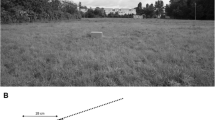Abstract
Two experiments measured the human ability to reproduce locomotor distances of 4.6–100 m without visual feedback and compared distance production with time production. Subjects were not permitted to count steps. It was found that the precision of human odometry follows Weber’s law that variability is proportional to distance. The coefficients of variation for distance production were much lower than those measured for time production for similar durations. Gait parameters recorded during the task (average step length and step frequency) were found to be even less variable suggesting that step integration could be the basis for non-visual human odometry.


Similar content being viewed by others
References
Andre J, Rogers S (2006) Using verbal and blind-walking distance estimates to investigate the two visual systems hypothesis. Percept Psychophys 68:353–361
Berthoz A, Israël I, Georges-Francois P, Grasso R, Tsuzuku T (1995) Spatial memory of body linear displacement: what is being stored? Science 269:95–98
Cheng K, Srinivasan MV, Zhang SW (1997) Error is proportional to distance measured by honeybees: Weber’s law in the odometer. Anim Cogn 2:11–16
Durgin FH, Gigone K (2007) Enhanced optic flow speed discrimination while walking: contextual tuning of visual coding. Perception 36:1465–1475
Durgin FH, Fox LF, Kim DH (2003) Not letting the left leg know what the right leg is doing: limb-specific locomotor adaptation to sensory-cue conflict. Psychol Sci 14:567–572
Durgin FH, Gigone K, Scott R (2005a) The perception of visual speed while moving. J Exp Psychol Hum Percept Perform 31:339–353
Durgin FH, Pelah A, Fox LF, Lewis J, Kane R, Walley KA (2005b) Self-motion perception during locomotor recalibration: more than meets the eye. J Exp Psychol Hum Percept Perform 31:398–419
Durgin FH, Reed C, Tigue C (2007) Step frequency and perceived self-motion. ACM: Trans Appl Percept 4(1) http://doi.acm.org/10.1145/1227134.1227139
Ellard CG, Wagar LS (2008) Plasticity of the association between visual space and action space in a blind-walking task. Perception 37:1044–1053
Gallistel CR (1980a) From muscles to motivation. Am Sci 68(4):398–409
Gallistel CR (1980b) The organization of action: a new synthesis. Lawrence Erlbaum, Hilladale
Glasauer S, Schneider E, Grasso R, Ivaneko YP (2007) Space-time relativity in self-motion reproduction. J Neurophysiol 97:451–461
Israël I, Berthoz A (1989) Contribution of the otoliths to the calculation of linear displacement. J Neurophysiol 62:247–263
Israël I, Grasso R, Georges-François P, Tsuzuki T, Berthoz A (1997) Spatial memory and path integration studied by self-driven passive linear displacement I: basic properties. J Neurophysiol 77:3180–3192
Lappe M, Jenkins M, Harris LR (2007) Travel distance estimation from visual motion by leaky path integration. Exp Brain Res 180:35–48
Loomis JM, Da Silva JA, Fujita N, Fukusima SS (1992) Visual space perception and visually directed action. J Exp Psychol Hum Percept Perform 18:906–921
Loomis JM, Klatzky RL, Golledge RG, Cicinelli JG, Pellegrino JW, Fry PA (1993) Nonvisual navigation by blind and sighted: assessment of path integration ability. J Exp Psychol Gen 122:73–91
Mittelstaedt M-L, Mittelstaedt H (2001) Idiothetic navigation in humans: estimations of path length. Exp Brain Res 139:318–332
Rakitin BC, Gibbon J, Penney TB, Malapani C, Hinton SC, Meck WH (1998) Scalar expectancy theory and peak-interval timing in humans. J Exp Psychol Anim Behav Process 24:15–33
Rieser JJ, Ashmead DH, Talor CR, Youngquist GA (1990) Visual perception and the guidance of locomotion without vision to previously seen targets. Perception 19:675–689
Rieser JJ, Pick HL Jr, Ashmead DH, Garing AE (1995) Calibration of human locomotion and models of perceptual-motor organization. J Exp Psychol Hum Percept Perform 21:480–497
Sekiya N, Nagasaki H, Ito H, Furuna T (1996) The invariant relationship between step length and step rate during free walking. J Hum Movement Stud 30:241–257
Steenhuis RE, Goodale MA (1988) The effects of time and distance on accuracy of target-directed locomotion: does an accurate short-term memory for spatial location exist? J Mot Behav 20:399–415
Thomson JA (1983) Is continuous visual monitoring necessary in visually guided locomotion? J Exp Psychol Hum Percept Perform 9:427–443
Wittlinger M, Wehner R, Wolf H (2006) The ant odometer: stepping on stilts and stumps. Science 312:1965–1967
Wohlgemuth S, Ronacher B, Wehner R (2001) Ant odometry in the third dimension. Nature 411:795–798
Acknowledgments
Mikio Akagi was supported by the Howard Hughes Medical Institute. Research supported by a Swarthmore College Faculty Research Grant and Lang Sabbatical Award to FHD.
Author information
Authors and Affiliations
Corresponding author
Rights and permissions
About this article
Cite this article
Durgin, F.H., Akagi, M., Gallistel, C.R. et al. The precision of locomotor odometry in humans. Exp Brain Res 193, 429–436 (2009). https://doi.org/10.1007/s00221-008-1640-1
Received:
Accepted:
Published:
Issue Date:
DOI: https://doi.org/10.1007/s00221-008-1640-1




